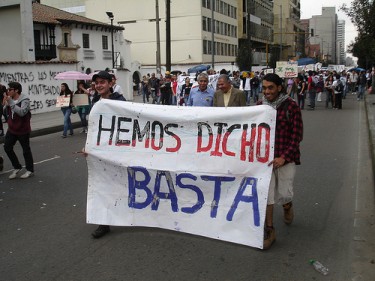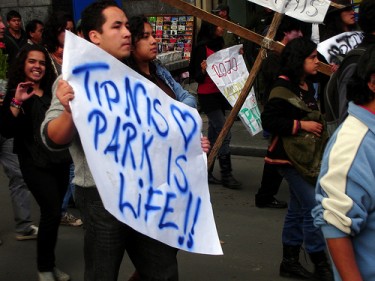As the Arab Spring unfolded throughout 2011, and as Spain’s indignados and the now worldwide ‘Occupy’ movement gained momentum, important social movements also rose up across Central and South America.
In 2011, Latin Americans took to the streets in big cities and small towns to defend their right to education, protect their lands from road and mining projects, and demand peace. Now, we remember the Global Voices Latin American team's coverage of these important mobilizations as we look back on 2011.
Student movements
Images of Chilean student protests made news around the world for months. While most international media focused on the recurring clashes between protesters and the police, on social networks citizens shared analysis, reports, images and videos from the ground.
For over six months, Chilean high school and university students staged various protests to demand an overhaul of the educational system. Students blogged and live-streamed their tomas (school occupations) documenting their experience inside the schools. They also uploaded citizen videos of cacerolazos (pot banging demonstrations) and the various incidents – negative and positive – that took place during protests, including a video which shows students stopping a group of violent protesters.
The student movement remained a hot topic on social networks as protests continued; in October, the Chilean Ministry of Interior presented an ‘Anti-Occupation’ bill to congress and later invoked a State Security Law, heating up the debate among netizens.
Meanwhile, in Colombia, students and professors held meetings and protested against a proposal to reform the higher education ‘Law 30′ that would, among other things, allow private investment in public universities.
Six months later, workers and students joined in a nationwide demonstration, and university students began a university strike demanding the government withdraw the bill to reform Law 30 from congress. On the eve of a nationwide protest scheduled for November 10, President Juan Manuel Santos announced he would withdraw the bill if students lifted the strike.
Despite the announcement, demonstrations were held on November 10 and in Bogotá students ‘occupied’ Bolivar Square. The next day, the Presidency's Twitter account reported the President had asked congress to remove the bill, and in the following days students began to gradually return to class.

"We've said: enough" Students protest on November 10, 2011 in Bogotá. Image by Flickr user Juan Camaron (CC BY-NC-SA 2.0)
But student protests had not ended for the year. Inspired by the student movements in Colombia and Chile, on November 24, students throughout Latin America marched to demand free, high-quality education.
In 2011, several Latin American countries faced a recurring dilemma: mines, roads, and other projects that promised economic growth and development also raised environmental concerns and threatened to infringe upon indigenous rights.
In June, Bolivian President Evo Morales announced a controversial project to build a road that would go through the Indigenous Territory National Park Isiboro Sécure (TIPNIS); in August, indigenous groups and their supporters began a 500 kilometer march towards La Paz to oppose the project.
In September, reports of police repression against the indigenous marchers spread on social networks. As a result, citizens began to mobilize both online and on the streets to show their support for the cause to defend TIPNIS. Netizens like Luis Chuquimia (@chuquijosel) [es] described the arrival of the marchers to La Paz on October 19:
las calles pacenhas….quedaron flores, mixtura, banderas de papel…lagrimas, abrazos…sonrisas..pasos que calan historias #TIPNIS ES VIDA
Finally, on October 21, President Morales announced the road will not go through TIPNIS.
In November, in neighboring Peru, bloggers reflected on several mining protests, including demonstrations against the Minas Conga gold mining project in Cajamarca. A strike caused the company to suspend the project, which, as Global Voices author Isabel Guerra explained:
[is] considered to be the largest mining investment in the history of Peru, [and] according to its opponents threatens to destroy some 20 lagoons, which serve as a foundation for local ecosystems and a source of water for farming communities.
Protests continued well into December despite the suspension, as opponents called for the total cancellation of the project; as a result, the government declared a state of emergency. The conflict is not yet resolved, but local bloggers have continued reporting from Cajamarca, and social networks users from all over Peru will keep sharing their reactions as events unfold.
Another mining controversy that has caused mixed opinions involves open-pit iron ore mine ‘Aratiri’ in Centro Chato, a small village in central Uruguay. In 2011, the controversial project divided Uruguayan netizens: some see it as an opportunity for employment and economic growth, while others are concerned about the environmental consequences and question whether the country will actually benefit from the mine’s profits. Developments will surely be followed closely by bloggers in 2012.
Marching for peace
Mexico's Drug War, a major military operation against drug cartels launched by President Felipe Calderón in December 2006, has left tens of thousands of victims. In 2011, Mexican citizens took to the streets and the Internet to say ‘enough’.
In May, Mexicans participated in a massive 4-day, nationwide march for peace, and demonstrations were also held in countries around the globe on May 8.
The march, which began in Cuernavaca on May 5 and ended in Mexico City on the 8, was organized by Mexican poet and activist Javier Sicilia, who became the leader of the Movement for Peace with Justice and Dignity [es] after his son was killed.
With the Mexican blogosphere buzzing with commentary on the issue of violence, GV en Español organized a blog carnival on “Citizenry, Violence and Blogs”. The following posts summarize the results of the carnival:
- Blog Carnival: Mexico – Verbalizing the Violence
- Blog Carnival: Mexico – Citizen Media on the Scene
- Blog Carnival: Mexico – Is Mexican Society Violent by Nature?
- Blog Carnival: Mexico – The United States and Violence in Mexico
Shortly after the Blog Carnival, reports of online activists becoming targets and victims of brutal killings stirred social networks. In a guest post for Global Voices Advocacy, ARTICLE19 explained:
Against a backdrop of endemic violence against journalists, social networks and other online communication platforms such as “Nuevo Laredo en Vivo” are increasingly being used by citizens – especially in Tamaulipas [to] break the silence around criminal activities that are not being reported in the press because of the pervading climate of fear and self-censorship.
As Mexico prepares to elect a new president in 2012, the War on Drugs and how to reach peace will surely keep the conversation on social networks going.
The Latin American team will work hard to amplify more of these important citizen voices from across the region in 2012. If you'd like to help us, we have several author vacancies for you to consider and there are multiple ways you can get involved in the Global Voices community. We hope you will join us as you continue reading, commenting, and sharing our stories; you can also follow us on Twitter @gvamericalatina.








5 comments
Excellent point on the Chilean protests — too many news organizations led with the confrontations, when the key story was that, regardless of the confrontations, the students became very popular, while Piñera plummeted in opinion polls to the worst evaluation of any Chilean prez since the return to democracy. The good news for Piñera was that he remained more popular than Congress and both political parties.
Let’s hope 2012 brings progress on all these issues. Feliz año